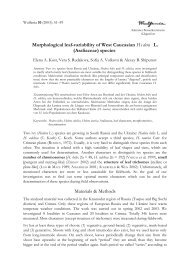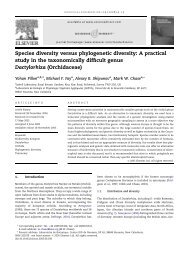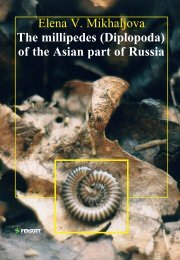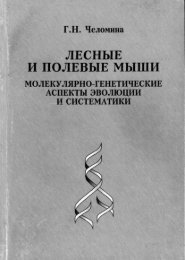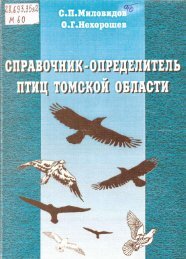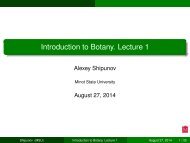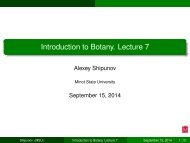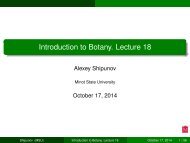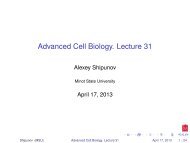- Page 3 and 4:
The designation employed and the pr
- Page 5 and 6:
EDITOR'S PREFACE This "paper form"
- Page 7 and 8:
The preparation of the Regional Lis
- Page 9 and 10:
The book was written in English. Th
- Page 11 and 12:
information: Category of the specie
- Page 13 and 14:
-Taxon endangered (EN) - a taxon wh
- Page 15 and 16:
-Mammals - 15 species (9 species in
- Page 17 and 18:
published in February 1997. It is a
- Page 19 and 20:
Synonyms: None Allium guttatum Stev
- Page 21 and 22:
Asparagus brachyphyllus Turczaninov
- Page 23 and 24:
Asparagus litoralis Steven, 1857 Sy
- Page 25 and 26:
Astrodaucus Uttoralis Prude, 1898 S
- Page 27 and 28:
Biology. Reproduction is by seeds a
- Page 29 and 30:
Distribution, Habitat type, Critica
- Page 31 and 32:
Calystegia soldanella (Linnaeus) R.
- Page 33 and 34:
Luks, Y. A., L. A. Privalova & I. V
- Page 35 and 36:
Biology. Flowering during Fruit-bea
- Page 37 and 38:
Threats. Draining of wetlands, crea
- Page 39 and 40:
Distribution, Habitat type, Critica
- Page 41 and 42:
Crambe pontica Stev. ex Rupr., 1869
- Page 43 and 44:
Cystoseira barbota (Good. & Wood, 1
- Page 45 and 46:
Bologa, A. S., 1987-88. Annotated b
- Page 47 and 48:
Distribution, Habitat type, Critica
- Page 49 and 50:
Dictiota dichotoma (Lamour, 1809) S
- Page 51 and 52:
Elymus pycnanthus (Godron) Melderis
- Page 53 and 54:
Synonyms: None. Ephedra distachya (
- Page 55 and 56:
Synonyms: Arenaria cephalotes Bieb.
- Page 57 and 58:
Synonyms: None Eryngium maritimum L
- Page 59 and 60:
Euphorbia paralias Linnaeus, 1753 S
- Page 61 and 62:
zapovednoy okhrany (Catalogue of Ra
- Page 63 and 64:
Conservation measures proposed. Cre
- Page 65 and 66:
Distribution, Habitat type, Critica
- Page 67 and 68:
Conservation measures taken. Includ
- Page 69 and 70:
Biology. Flowering during V-VII, fr
- Page 71 and 72:
Biology. An annual or perennial her
- Page 73 and 74:
Threats. Destruction of its locatio
- Page 75 and 76:
Biology. Flowering and fruit-bearin
- Page 77 and 78: only localities in the Crimea). Lim
- Page 79 and 80: Synonyms: None Nymphoidespeltata S.
- Page 81 and 82: Synonyms: None Ornithogalum refract
- Page 83 and 84: Synonyms: None. Pancratium maritimu
- Page 85 and 86: Parapholis incurva (Linnaeus) C.E.H
- Page 87 and 88: Rubtsov, N. I. (Ed.), 1972. Opredel
- Page 89 and 90: IUCN Status World level: Black Sea
- Page 91 and 92: Phyllophora nervosa (P.C. Grev., 18
- Page 93 and 94: Katukov, A. B., 1983. Phyllophora v
- Page 95 and 96: Distribution. Mostly in the north-w
- Page 97 and 98: Distribution, Habitat type, Critica
- Page 99 and 100: Conservation measures proposed. Cre
- Page 101 and 102: Conservation measures taken. One of
- Page 103 and 104: Conservation measures taken. None.
- Page 105 and 106: Threats. Changes in the water regim
- Page 107 and 108: Conservation measures taken. The sp
- Page 109 and 110: Seeds have good germination power (
- Page 111 and 112: Synonyms: None. Zostera marina (Lin
- Page 113 and 114: Synonyms: Zostera nana Roth. Zoster
- Page 115 and 116: PART II. ANIMALS Acipenser gtildens
- Page 117 and 118: Adoption of strict national measure
- Page 119 and 120: Biology. A migratory, anadromous sp
- Page 121 and 122: Aidablennius sphynx Valenciennes, 1
- Page 123 and 124: Synonyms: Anax imperator Leach, 181
- Page 125 and 126: Beschovski, V., 1964b. Odonata (Dra
- Page 127: Biology. Well adapted to the surfac
- Page 131 and 132: Aporrhais pespelecani (Linnaeus, 17
- Page 133 and 134: Apseudopsis ostroumovi Bacescu & Ca
- Page 135 and 136: Synonyms: Ardea ralloides. Ardeola
- Page 137 and 138: Aythya nyroca Guldenstadt, 1770 Syn
- Page 139 and 140: Betone betone euxini (Günther, 189
- Page 141 and 142: References Banarascu, P., 1964. Pis
- Page 143 and 144: Population trends. Declining. Threa
- Page 145 and 146: macrophyte fauna of the Romanian Bl
- Page 147 and 148: Population trends. Before 1940, fou
- Page 149 and 150: Threats. Cattle-grazing, pollution
- Page 151 and 152: abundance recorded north of Cape Ma
- Page 153 and 154: migration from September to early O
- Page 155 and 156: Synonyms: Callionymus risso Le Sueu
- Page 157 and 158: Calopteryx splendens - complex Syno
- Page 159 and 160: Conservation measures taken. Some o
- Page 161 and 162: Calopteryx virgo - complex Synonyms
- Page 163 and 164: References Bartenef, A. N., 1912. D
- Page 165 and 166: Sea; in the Atlantic known to occur
- Page 167 and 168: Synonyms: None. Common names: None.
- Page 169 and 170: Chaetogammarus ischnus major (Stebl
- Page 171 and 172: Chromogobius quadrivittatus Steinda
- Page 173 and 174: Ciconia nigra Linnaeus, 1758 Synony
- Page 175 and 176: similar. Often the two species gath
- Page 177 and 178: Clupeonella cultriventris Nordmann,
- Page 179 and 180:
Synonyms: None. Common names. None.
- Page 181 and 182:
Colpocyclops longispinosus (Monchen
- Page 183 and 184:
Synonyms: None. Conger conger (Linn
- Page 185 and 186:
Coryphoblennius galerita (Linnaeus,
- Page 187 and 188:
Delphinus delphis Linnaeus, 1758 Sy
- Page 189 and 190:
cases of dolphins entangled in pela
- Page 191 and 192:
Dikerogammarus vilosus (Sovinskii,
- Page 193 and 194:
Diogenes pugilator (Roux, 1828) Syn
- Page 195 and 196:
Diplodus annularis Linnaeus, 1758 S
- Page 197 and 198:
Donacilla cornea (Poli, 1791) Synon
- Page 199 and 200:
Epallage fatime (Charpentier, 1840)
- Page 201 and 202:
Dumont, H. J. A review of the drago
- Page 203 and 204:
Distribution, Habitat type, Critica
- Page 205 and 206:
Falco cherrug (Gray, 1834) Synonyms
- Page 207 and 208:
References Ardamatzkaia, T. B. & A.
- Page 209 and 210:
irds occur throughout the area: on
- Page 211 and 212:
Felis silvestris Schreber, 1777 Syn
- Page 213 and 214:
Synonyms: None Glareola nordmanni N
- Page 215 and 216:
Glareola pratincola (Linnaeus, 1758
- Page 217 and 218:
Gobius bucchichi Steindachner, 1870
- Page 219 and 220:
Gobius cobitis (Pallas, 1811) Synon
- Page 221 and 222:
Synonyms: None Grus grus Linnaeus,
- Page 223 and 224:
References Grinchenko, A .B., 1987.
- Page 225 and 226:
small molluscs and copepods along t
- Page 227 and 228:
Conservation measures taken. None.
- Page 229 and 230:
on the large basins in the Romanian
- Page 231 and 232:
Hörig, H., 1986. Seeadlerbestand w
- Page 233 and 234:
Threats. Turbidity in shallow zones
- Page 235 and 236:
Biology. A euryhaline organism, liv
- Page 237 and 238:
Synonyms: None. Hemimysis serrata (
- Page 239 and 240:
Synonyms: None. Common names: None.
- Page 241 and 242:
Synonyms: Himantopus himantopus Lin
- Page 243 and 244:
Hippocampus guttulatus microstephan
- Page 245 and 246:
Hydroprogne caspia (Pallas, 1770) S
- Page 247 and 248:
Synonyms: None Iphigenella acanthop
- Page 249 and 250:
Iphigenella andrussovi (Sars, 1896)
- Page 251 and 252:
Polischuk, V. V., 1994. Iphigenella
- Page 253 and 254:
Population trends. Stable in the re
- Page 255 and 256:
Threats. Silty lower river reaches;
- Page 257 and 258:
Conservation measures proposed. Inc
- Page 259 and 260:
Conservation measures proposed. Inc
- Page 261 and 262:
Threats. Breakdown of the hydrochem
- Page 263 and 264:
coast of the Black Sea; also in the
- Page 265 and 266:
Lutra lutra Linnaeus, 1758 Synonyms
- Page 267 and 268:
International Conventions for biodi
- Page 269 and 270:
Population trends. Abundant in the
- Page 271 and 272:
Threats. Sand dredging, trawling. C
- Page 273 and 274:
Mergus serrator of Black Sea origin
- Page 275 and 276:
May for reproduction (at 6 °C); re
- Page 277 and 278:
Moerisia maeotica (Ostroumov, 1896)
- Page 279 and 280:
Opredelitel fauny Chernogo i Azovsk
- Page 281 and 282:
individuals still live between Zong
- Page 283 and 284:
23 °C. First reproduction at the a
- Page 285 and 286:
Population trends. Declining. Threa
- Page 287 and 288:
Biology. Reproduction from March to
- Page 289 and 290:
Conservation measures taken. None.
- Page 291 and 292:
Threats. Human disturbance, hunting
- Page 293 and 294:
Population trends. Unknown. Threats
- Page 295 and 296:
acteria and Infusoria. The female l
- Page 297 and 298:
Biology. A typical contourobiont in
- Page 299 and 300:
Biology. A sedentary sestonophage.
- Page 301 and 302:
Pachygrapsus marmoratus Fabricius,
- Page 303 and 304:
Bacescu M., G. I. Muller, M-T Gomoi
- Page 305 and 306:
Biology. A vegetarian, browsing on
- Page 307 and 308:
frequent are floating nests near op
- Page 309 and 310:
the Azov-Black Sea area (lakes of t
- Page 311 and 312:
Synonyms: Phalacrocorax albus Tray
- Page 313 and 314:
Phocoena phocoena Linnaeus, 1758 Sy
- Page 315 and 316:
coasts, single animals and small gr
- Page 317 and 318:
Pilumnus hirtellus Linnaeus, 1758 S
- Page 319 and 320:
Borcea, I., 1926. Données sommaire
- Page 321 and 322:
Fledging at the age of 50-55 days.
- Page 323 and 324:
Plegadis falcinellus Linnaeus, 1766
- Page 325 and 326:
Pomatoschistus minutus (Pallas, 177
- Page 327 and 328:
Synonyms: None. Common names: None.
- Page 329 and 330:
Potamon tauricum Czerniavsky, 1884
- Page 331 and 332:
Makarov, Y. M., 1994. Prisnovodny k
- Page 333 and 334:
Biology. Reproduction: April-May. E
- Page 335 and 336:
Conservation measures taken. None.
- Page 337 and 338:
Black Sea coast in late September-e
- Page 339 and 340:
Krivenko, V., 1983. Krasnazobaia ka
- Page 341 and 342:
Distribution, Habitat type, Critica
- Page 343 and 344:
Scomber scombrus Linnaeus, 1758 Syn
- Page 345 and 346:
Radu, G., E. Leonte, G., Butoi, F.
- Page 347 and 348:
littoral areas of the north-western
- Page 349 and 350:
Habitat type, Critical habitats, Li
- Page 351 and 352:
Threats. Overfishing, illegal fishi
- Page 353 and 354:
Population trends. After 1970, very
- Page 355 and 356:
Breeding density can be up to 5 nes
- Page 357 and 358:
Spicara smaris (Linnaeus, 1758) Syn
- Page 359 and 360:
Symphodus ocellatus (Forsskal, 1775
- Page 361 and 362:
Symphodus tinca (Linnaeus, 1758) Sy
- Page 363 and 364:
Synonyms: None. Syngnatus tenuirost
- Page 365 and 366:
Syngnathus typhle (Linnaeus, 1758)
- Page 367 and 368:
Tado ma ferruginea (Pallas, 1764) S
- Page 369 and 370:
Thunnus thynnus Linnaeus, 1758 Syno
- Page 371 and 372:
FAO, 1973. Species identification s
- Page 373 and 374:
Population trends. Declining. Threa
- Page 375 and 376:
Biology. Feeds mainly on crustacean
- Page 377 and 378:
Crimea in autumn, but migratory rou
- Page 379 and 380:
(Mammals of the Soviet Union. Vol.2
- Page 381 and 382:
Distribution, Habitat type, Critica
- Page 383 and 384:
Uranoscopus scaber (Linnaeus, 1758)
- Page 385 and 386:
Xantho poressa (Qlivii, 1792) Synon
- Page 387 and 388:
Synonyms: Xiphias gladius Gunther,
- Page 389 and 390:
Zosterisessor ophiocephalus Pallas,
- Page 391 and 392:
References Abuladze, A., 1993. The
- Page 393 and 394:
Bacescu, M., G. I. Muller & M. T. G
- Page 395 and 396:
Borcea, L, 1926-1927. Note sur les
- Page 397 and 398:
Davis P. H., 1965-1985. Flora of Tu
- Page 399 and 400:
Gomoiu, M.-T., 1976. Ecological stu
- Page 401 and 402:
Karapetkova, M., 1985. Red book of
- Page 403 and 404:
Lebedeva, M., 1979. Migracii chemog
- Page 405 and 406:
Monchenko, V. I., 1978. The allocat
- Page 407 and 408:
Polischuk, V. V., 1994. Iphigenella
- Page 409 and 410:
Sabinevskii, B. & T. Ardamatskaia,
- Page 411 and 412:
Svetovidov, A. N. 1964. Ryby Cherno
- Page 413 and 414:
Vulff, E.W., 1951. Flora Kryma. Tom




